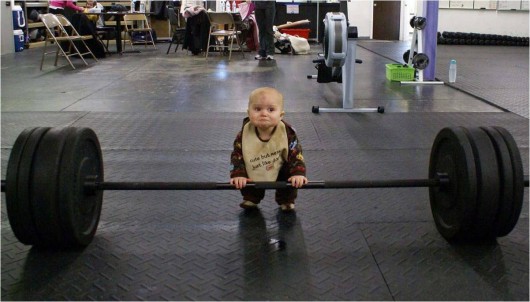Yes, people do abandon fitness programs. A lot.
- Many new exercise “intenders” will abandon their workout routines within two weeks of their New Year’s resolutions, and about half will quit by June.[1]
- 67% of gym members never go. [2]
- 1/3 of people who buy online fitness and health products never even download them.
People have serious intentions. They are determined to stick to a workout plan. They buy an expensive gym membership. Yet they quit.
Why is that?
The reasons for exercise and fitness abandonment have been researched quite well in social and health psychology. Here are the top six reasons people quit an exercise or health program.
1. No Time

One of the most common reasons given for exercise abandonment is “I have no time.” [3] Lack of time goes beyond exercise time. It may include the time to go to a gym or time conflicts with other activities.
More often than not this is a perceived barrier, not based on reality. People find time to watch TV for hours in the evening, go for drinks with friends, and surf Quora – if they wanted, they could find 30 minutes a day to exercise.
If someone paid you $1,000 every day to exercise for 30 minutes, would you be too busy?
Don’t quit:
There are a number of strategies to deal with lack of time. One of my favorite is the elimination of decisions.
- Schedule workouts beforehand.
- Treat the schedule as set in stone (like you would a dentist appointment).
- Get ready the day before: pack the gym bag, put it in the car, ready the protein shake – eliminate everything that could serve as excuse (“Oh, I forgot to wash my gym clothes, now I can’t go”).
Another strategy is to add social pressure. For me this was the biggest advantage of having a personal trainer: I knew he was waiting for me and I had to come up with a really good reason to cancel training.
2. Want Too Much, Too Quick

People are prone to dropping out if exercise does not meet their expectations. [4]
If you expect to lose weight quickly and don’t, you are likely to abandon the fitness routine.
If you expect to gain muscle fast and don’t, it’s likely that you won’t stick to the program.
If you overdo it (and for complete beginners, aerobic activity of three times per week may be “overdoing it” – twice per week may be better to recover and get used to exercise), you are more likely to quit.
Don’t quit:
SMART goals are imperative. They should be Specific, Measurable, Attainable,Realistic and Timely. Get feedback on your goals from a trainer or from a peer group. Measure progress.
3. Wrong Kind of Motivation

Motivation is a weird one. It seems like there is a switch that, when it gets flipped, just makes you do something. Researchers have determined that self-generated and self-determined motivation is more effective than externally imposed efforts to change health behaviors. [5] [6]
“I exercise because I personally want to. I like the feelings of progress. I do it because it’s the means to an end that I value.”
If you exercise or eat well because you think it is important or because you value good health, you will be more likely to stick to it than if you start because of external motivation such as shame or guilt.
An important motivation factor is a person’s physical self-efficacy or confidence in ability to do exercise and be consistent with workouts. High self-efficacy is particularly important for exercise adherence among women.
Self-worth (the foundations of a person’s specific values about exercise) is a key factor in exercise adherence for women. If a woman has a belief that she is “not worth it” (ie I’m worth the cost of a gym membership, the time I spend on myself, etc), she is more likely to stick to a program.[7]
Dont’ quit:
Find out what motivates you. Educate yourself about the value of physical activity to health and quality of life.
Shift your focus from lofty expectations, like losing 20 pounds, to the positive experiences of exercise, like its effects on mood and the feeling of well-being.
4. Lack of Enjoyment, Experience or Fear of Pain

Common sense already says that if you don’t enjoy an activity, you are not going to keep it up, Unfortunately, many end up doing a certain kind of exercise just because they have been told “it’s good for you”. Running may be such a thing. For many it’s simply boring. Coupled with the fact that it’s not very effective for weight loss or strength gain, it’s no wonder that so many give up running come fall.
Injuries are also a factor in exercise abandonment. If combined with other factors, harmless knee pain can lead people to give up on exercise completely, when they really should work to find alternate or rehabilitating exercises.
Don’t quit:
Pick an exercise that you like. Learn how to warm up and cool down to prevent injury. Learn how to exercise with good form
5. Poor Access to Exercise Facilities or Unpleasant Exercise Environment

It appears that easy access to exercise facilities enhances exercise adherence [8]. Also, satisfaction with a workout facility (ie the perception that equipment is safe and the facility is user-friendly) is also highly associated with exercise adherence. Interestingly, watching others exercise also helps motivate people to continue with their own workout plan.
Home exercise programs are generally given up much easier. Our homes are typically associated with relaxation and not with strenuous physical activity. That’s why so many ab-wheels, cross trainers and Insanity DVDs stay in a corner unused.
Don’t quit:
Try to fit in your exercise as best as possible into your schedule and don’t be afraid to experiment. Maybe you can use the lunch break to go a gym near your office. Find a gym that fits your style or, if you have the option, build a home gym and make it fit your style.
6. Lack of Support

Numerous studies show that perceived or real lack of social support from a significant other or meaningful friend is highly associated with exercise abandonment [8].
Don’t quit:
Explain your interest in physical well-being to friends and family. Ask them to support your efforts. Invite friends and family members to exercise with you. Get a gym buddy or join a gym class.
How to Never Quit a Fitness Program
- Work on your self-perception and inner motivation. Make it clear to yourself that you are exercising to improve your health and well-being.
- Reinforce that with social support and professional feedback.
- Set SMART goals (Specific, Measurable, Attainable, Realistic, Timely).
- Set up a specific training plan.
- Go do it.
[2] International Health, Racquet & Sportsclub Association, Mint, Bureau of Labor Statistics, Club Industry, Club Manager Central, via Gym Membership Statistics
[3] Brinthaupt, T. M., Kang, M., & Anshel, M. H. (2010). A delivery model for overcoming psycho-behavioral barriers to exercise. Psychology of Sport and Exercise, 11, 259-266.
[4] International Health, Racquet & Sportsclub Association, Mint, Bureau of Labor Statistics, Club Industry, Club Manager Central
[5] Rollnick, S., Mason, P., & Butler, C. (1999). Health behaviour change: A guide for practitioners.
[6] Brinthaupt, T. M., Kang, M., & Anshel, M. H.Changes in Exercise Commitment Following a Values-Based Wellness Program as per www.sporttudomany.hu
[7] Huberty, J.L., et al. 2008. Explaining long-term exercise adherence in women who complete a structured exercise program. Research Quarterly for Exercise and Sport, 79 (3), 374–84.
[8] Trost, S.G., et al. 2002. Correlates of adults’ participation in physical activity: Review and update. Medicine & Science in Sports & Exercise, 34 (12), 1996–2001.



